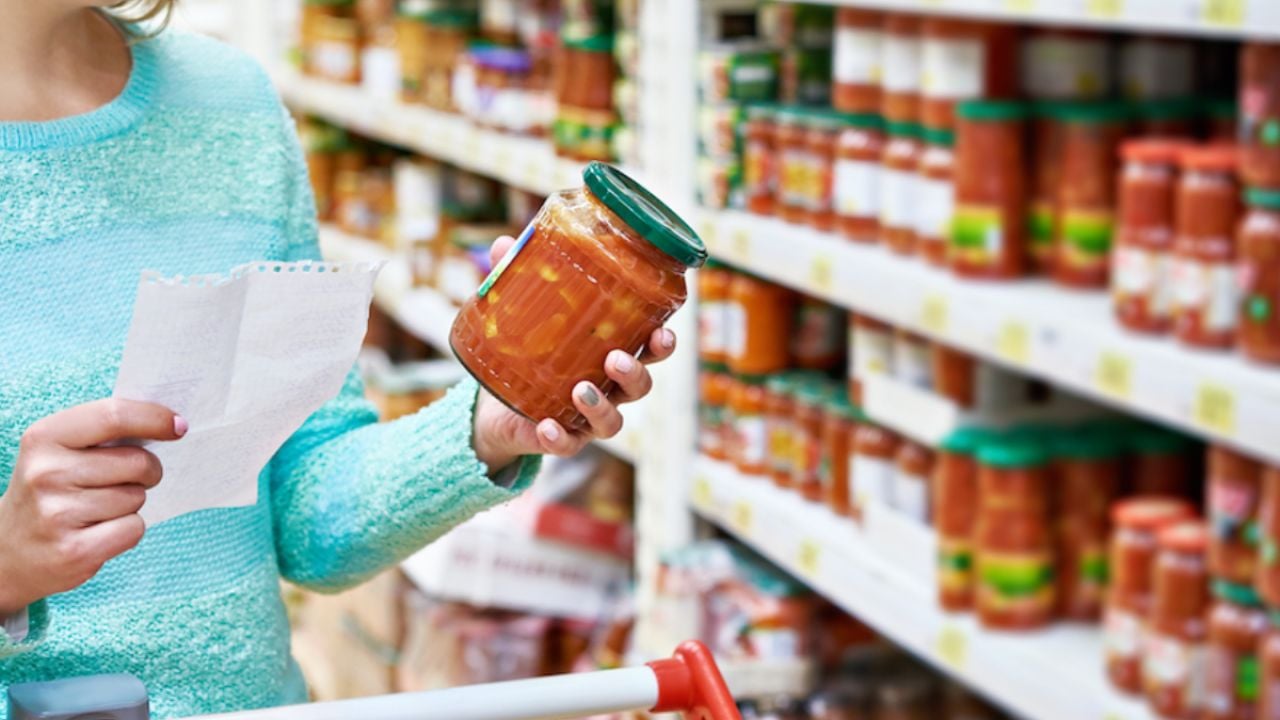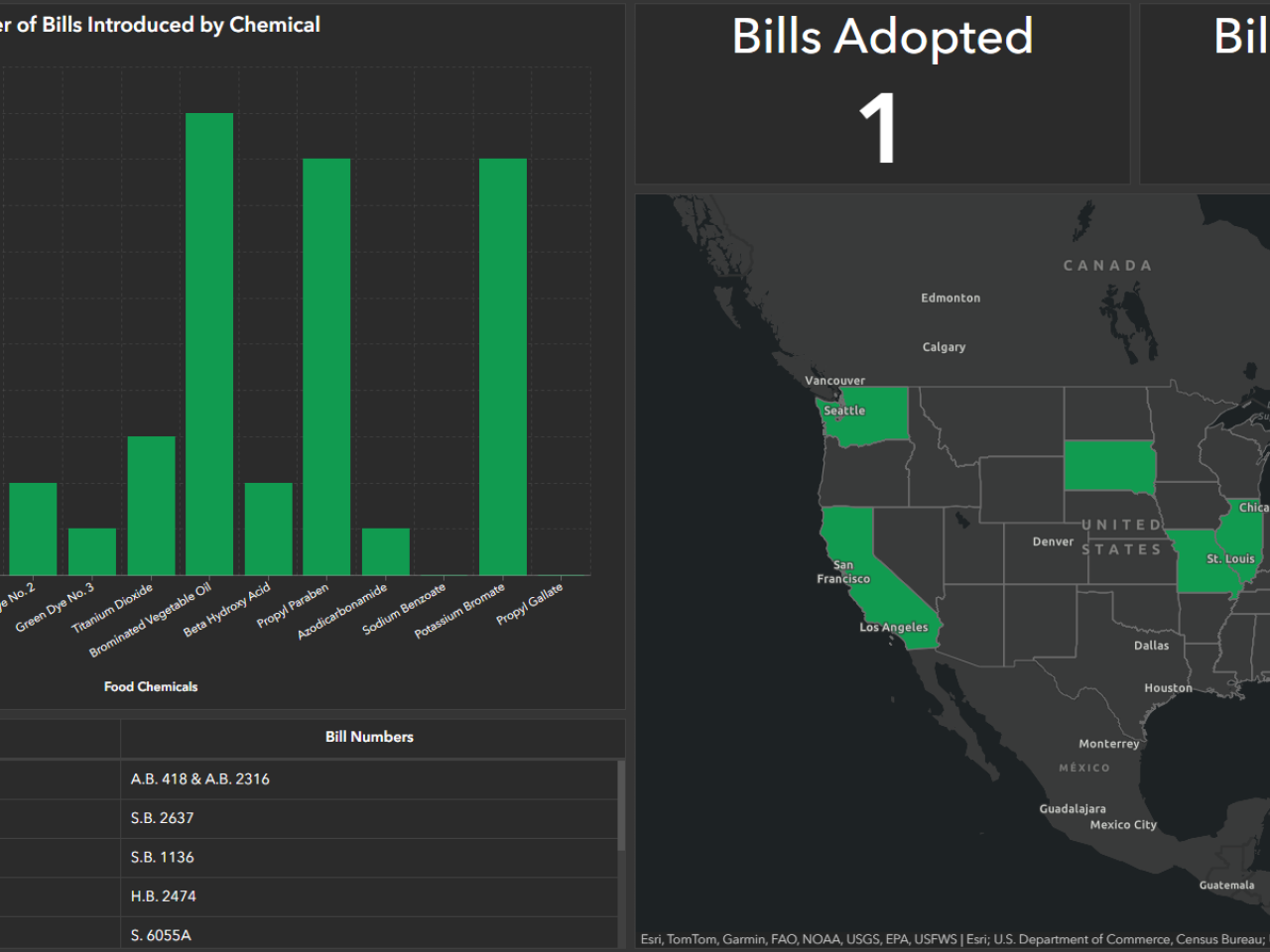
Updated on Monday, April 22, 2024.
Thousands of chemicals are allowed for use in food sold in this country. And while most of these are likely safe to eat, some have been linked to serious health harms.
Last year, the California Food Safety Act, which banned four toxic chemicals from food sold, manufactured or distributed in the state, was signed into law. The chemicals were potassium bromate, propyl paraben, Red Dye No. 3 and brominated vegetable oil, or BVO.
Following the success of this landmark legislation, 11 new state bills to target harmful food chemicals have been introduced this year. Collectively, they seek to ban, in addition to the four California chemicals, titanium dioxide, Red Dye No. 40, Yellow Dye No. 5, Yellow Dye No. 6, Blue Dye No. 1, Blue Dye No. 2, Green Dye No. 3, BHA and azodicarbonamide. The potential health risks of each of these chemicals are well documented.
| Chemical |
|---|
| Titanium dioxide: genotoxicity, potential immunotoxicity and neurotoxicity*✝ |
| Red Dye No. 3: risks to brain development in children, behavioral difficulties, increased risk of cancer |
| Red Dye No. 40: risks to brain development in children, behavioral difficulties, may contain carcinogenic contaminants |
| Yellow Dye No. 5: risks to brain development in children, behavioral difficulties, genotoxicity, may contain carcinogenic contaminants |
| Yellow Dye No. 6: risks to brain development in children, behavioral difficulties, may contain carcinogenic contaminants, potential increased risk of cancer |
| Blue Dye No. 1: risks to brain development in children, behavioral difficulties |
| Blue Dye No. 2: risks to brain development in children, behavioral difficulties, potential increased risk of cancer |
| Green Dye No. 3: risks to brain development in children, behavioral difficulties, potential increased risk of cancer |
| BHA: increased risk of cancer (California Prop 65 listing), hormone disruption |
| Azodicarbonamide: forms carcinogenic byproducts |
| Potassium bromate: increased risk of cancer (California Proposition 65 listing) |
| BVO: harm to the nervous system, the reproductive system and thyroid hormone function |
| Propyl paraben: hormone disruption and harm to the reproductive system |
* These health harms are associated with the consumption of titanium dioxide in food, not with the use of titanium dioxide in personal care products and sunscreens applied topically.
✝ EWG will reevaluate the use of titanium dioxide in cosmetic lip and oral care products during the next EWG Verified® annual science review.
Lack of federal regulation forces states to step in
Nearly 99 percent of food chemicals introduced since 2000 were approved by the food and chemical industry, not the Food and Drug Administration.
Even when the FDA does assess chemicals for safety, it has been extremely slow and rarely reevaluates earlier decisions, even when new science is available. So the vast majority of chemicals in our food supply haven’t been reviewed for safety for decades, if at all.
The FDA’s most recent list of chemicals “under review” includes only five of the 13 chemicals being targeted by state bills: potassium bromate, BVO, propyl paraben, Red Dye No. 3 and titanium dioxide. The agency’s plan for post-market assessments remains unclear, and the process as a whole lacks transparency. And it could be years before the FDA concludes its review of these chemicals – if it ever does.
Time and again the FDA has failed to act when it comes to regulating potentially harmful food ingredients. In the absence of federal action, states have stepped up to protect their consumers from harmful food chemicals.
States that have introduced legislation
California
A.B. 2316 would ban the food additives Red Dye No. 40, Yellow Dye No. 5, Yellow Dye No 6, Blue Dye No. 1, Blue Dye No. 2, Green Dye No. 3 and titanium dioxide from food served in public schools in the state.
The remaining bills under consideration address food chemicals manufactured, sold or distributed in the state.
Illinois
S.B. 2637 would ban the food additives potassium bromate, propyl paraben, Red Dye No. 3 and BVO.
Maryland
S.B. 1136 would ban the food additives potassium bromate, propyl paraben, Red Dye No. 3 and BVO.
Missouri
H.B. 2474 would ban the food additives potassium bromate, propyl paraben, Red Dye No. 3 and BVO.
New Jersey
A. 4132 would ban the food additives potassium bromate, propylparaben, Red Dye No. 3 and BVO.
New York
S. 6055A would ban the food additives potassium bromate, titanium dioxide, propyl paraben, Red Dye No. 3, BVO, BHA and azodicarbonamide.
Pennsylvania
H.B. 2116 would ban the artificial food dyes Red Dye No. 3, Red Dye No. 40, Yellow Dye No. 5, Yellow Dye No. 6, Blue Dye No. 1 and Blue Dye No. 2.
H.B. 2117 would ban the food additives potassium bromate, BVO and BHA.
Rhode Island
H. 7300 would ban the food additives potassium bromate, propyl paraben, Red Dye No. 3 and BVO.
South Dakota
H.B. 1169 would ban the food additives potassium bromate, propyl paraben, Red Dye No. 3 and BVO.
Washington
H.B. 1921 would ban the food additives potassium bromate, propyl paraben, Red Dye No. 3 and BVO.
West Virginia
H.B. 5086 would ban the food additives potassium bromate, propyl paraben, Red Dye No. 3 and BVO.
To help track the scope of these food chemical bills across the country, we created a map of all the states that have introduced and passed bills banning harmful food chemicals.
Lowering your exposure to harmful food chemicals
Until the FDA takes action, states should continue to take measures to protect their consumers from these toxic food chemicals.
But while we await state and federal regulation, if you want to lower your intake of harmful food ingredients, you can:
- Consult EWG’s Food Scores database to find products that don’t use toxic food chemicals like the ones included in these state bills. When you’re on the go, use our Healthy Living app to find products.
- Choose packaged foods that are certified organic, whenever possible. These products must meet strong standards that protect consumers from exposure to potentially harmful additives.
- When possible and affordable, limit your intake of ultra-processed foods. Many contain concerning ingredients.




